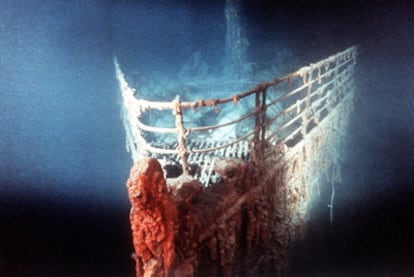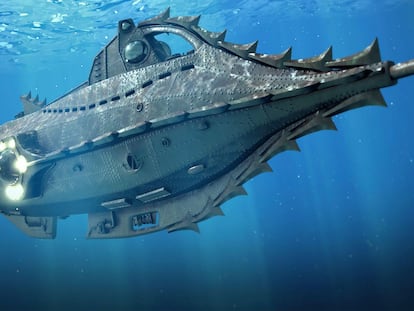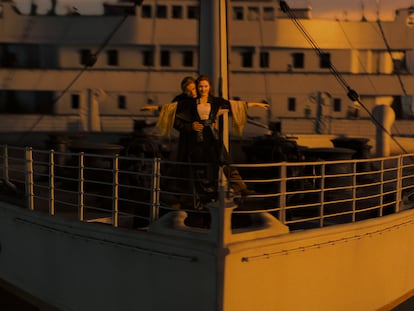A search is underway for missing submarine that takes people to see Titanic
The vessel was reported overdue on Sunday night, about 435 miles (700 kilometres) south of St. John’s, Newfoundland

A rescue operation was underway deep in the waters of the Atlantic Ocean on Monday in search of a submersible vessel that carries people to view the wreckage of the Titanic.
The Joint Rescue Coordination Centre in Halifax, Nova Scotia said the vessel was reported overdue around 9:13 p.m. Sunday, about 435 miles (700 kilometres) south of St. John’s, Newfoundland. Lt. Cmdr. Len Hickey said a Canadian Coast Guard vessel and military aircraft were assisting the search effort, which was being led by the U.S. Coast Guard in Boston.
OceanGate Expeditions confirmed the search for its five-person submersible and said its focus was on those aboard the vessel and their families.
“We are deeply thankful for the extensive assistance we have received from several government agencies and deep sea companies in our efforts to reestablish contact with the submersible,” the company said in a statement. “We are working toward the safe return of the crewmembers.”
David Concannon, an adviser to the company, said Oceangate lost contact with the sub Sunday morning. It had a 96-hour oxygen supply, he said in an email to The Associated Press on Monday afternoon. “Now 32 hours since sub left surface,” said Concannon, who said he was supposed to be on the dive but could not go due to another client matter. He said officials are working to get a remotely operated vehicle that can reach a depth of 6,000 meters (about 20,000 feet) to the site as soon as possible.
Action Aviation confirmed that its company chairman, U.K. businessman Hamish Harding, was one of the tourists on board. The company’s managing director, Mark Butler, told the AP that the crew set out on Friday.
“Every attempt is being made for a rescue mission. There is still plenty of time to facilitate a rescue mission, there is equipment on board for survival in this event,” Butler said. “We’re all hoping and praying he comes back safe and sound.”
The expedition was OceanGate’s third annual voyage to chronicle the deterioration of the iconic ocean liner that struck an iceberg and sank in 1912, killing all but about 700 of the roughly 2,200 passengers and crew. Since the wreckage’s discovery in 1985, it has been slowly succumbing to metal-eating bacteria, and some have predicted the ship could vanish in a matter of decades as holes yawn in the hull and sections disintegrate.
The initial group of tourists was funding the expedition by spending anywhere from $100,000 to $150,000 apiece.
The latest trip was scheduled to depart from St. John’s, Newfoundland, in early May and finish up at the end of June, according to a court documents filed by the company in April with a U.S. District Court in Virginia that presides over Titanic matters.
Unlike submarines that leave and return to port under their own power, submersibles require a ship to launch and recover them. OceanGate hired the Canadian vessel Polar Prince, a medium duty icebreaker that was formerly operated by the Canadian Coast Guard, to ferry dozens of people and the submersible craft to the North Atlantic wreck site.
The 5-person submersible, named Titan, is capable of diving 4,000 meters or 13,120 ft. “with a comfortable safety margin,” OceanGate said in its filing with the court.
It weighs 20,000 pounds (9,072 kilograms) in the air, but is ballasted to be neutrally buoyant once it reaches the seafloor, the company said.
The Titan is made of “titanium and filament wound carbon fiber” and has proven to “withstand the enormous pressures of the deep ocean,” OceanGate stated. OceanGate told the court that Titan’s viewport is “the largest of any deep diving submersible” and that its technology provides an “unrivaled view” of the deep ocean.
Chris Parry, a retired navy rear admiral from the U.K., told Sky News that the rescue taking place was “a very difficult operation.”
“The actual nature of the seabed is very undulating. Titanic herself lies in a trench. There’s lots of debris around. So trying to differentiate with sonar in particular and trying to target the area you want to search in with another submersible is going to be very difficult indeed.”
Sign up for our weekly newsletter to get more English-language news coverage from EL PAÍS USA Edition
Tu suscripción se está usando en otro dispositivo
¿Quieres añadir otro usuario a tu suscripción?
Si continúas leyendo en este dispositivo, no se podrá leer en el otro.
FlechaTu suscripción se está usando en otro dispositivo y solo puedes acceder a EL PAÍS desde un dispositivo a la vez.
Si quieres compartir tu cuenta, cambia tu suscripción a la modalidad Premium, así podrás añadir otro usuario. Cada uno accederá con su propia cuenta de email, lo que os permitirá personalizar vuestra experiencia en EL PAÍS.
¿Tienes una suscripción de empresa? Accede aquí para contratar más cuentas.
En el caso de no saber quién está usando tu cuenta, te recomendamos cambiar tu contraseña aquí.
Si decides continuar compartiendo tu cuenta, este mensaje se mostrará en tu dispositivo y en el de la otra persona que está usando tu cuenta de forma indefinida, afectando a tu experiencia de lectura. Puedes consultar aquí los términos y condiciones de la suscripción digital.
More information
Archived In
Últimas noticias
Most viewed
- Reinhard Genzel, Nobel laureate in physics: ‘One-minute videos will never give you the truth’
- Oona Chaplin: ‘I told James Cameron that I was living in a treehouse and starting a permaculture project with a friend’
- Pablo Escobar’s hippos: A serious environmental problem, 40 years on
- Why we lost the habit of sleeping in two segments and how that changed our sense of time
- Charles Dubouloz, mountaineering star, retires at 36 with a farewell tour inspired by Walter Bonatti










































